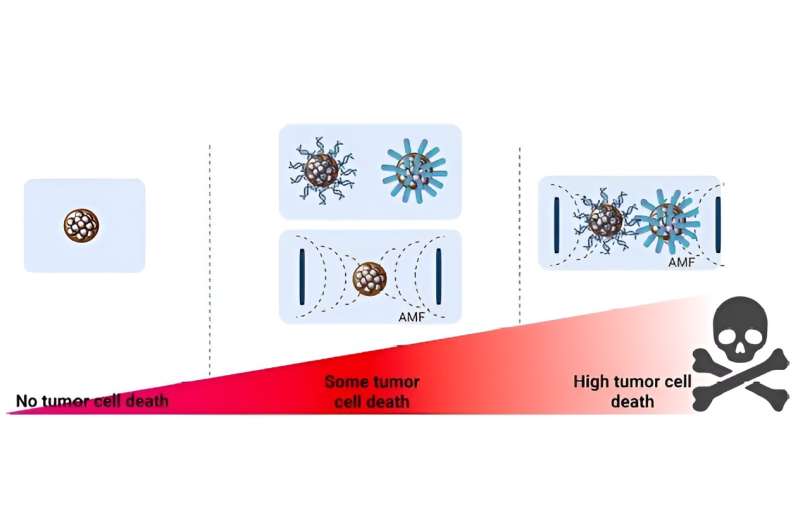This article has been reviewed according to Science X's editorial process and policies. Editors have highlighted the following attributes while ensuring the content's credibility:
fact-checked
trusted source
proofread
A combination of multicore magnetic nanoparticles and chemotherapy drugs achieves greater efficacy against cancer cells

The path to a cure for cancer is not unique, as the disease is an extremely complex process. Multiple factors are involved in the process of effectively eliminating a tumor and therefore, being able to have different strategies against cancer is key in this regard.
In a recent study, researchers at "IMDEA Nanociencia" institute propose the use of multicore magnetic nanoparticles, a new type for which hardly any studies have been carried out on their efficacy against cancer in physiological environments. Specifically, their study analyzes the effects of multinucleus nanoparticles on various cancer cell lines.
Multicore nanoparticles are aggregates of smaller nanoparticles. The selection of these multicore nanoparticles has been made based on the fact that they are among the most heated in magnetic hyperthermia processes.
In a process of magnetic hyperthermia, the magnetic material—in this case the nanoparticles—is subjected to an alternating magnetic field that raises its temperature in a controlled way. Hypothetically, if these particles were found in the environment of a tumor, they would heat the cells of the tumor above their critical temperature, causing the death of the cancer cells and deactivating the tumor.
Currently, magnetic hyperthermia is found in clinical trials in a few hospitals around the world. Therefore, research is key so that alternative treatments can reach patients and be used in all types of tumors.
In their work, researchers have studied the efficacy of two distinct nanoparticle morphologies in reducing the viability of cancer cell lines. Further, they have added two types of anti-cancer molecules to the surface of the nanoparticles to enhance the effect: a chemotherapy drug and microRNAs. MicroRNAs are small molecules of ribonucleic acid (RNA), which in this case act as tumor suppressors.
The modified nanoparticles have been internalized by commercial cell lines of various types of cancer: pancreatic, uvea, lung, colon and breast. The use of these cell lines gives scientists anywhere in the world the possibility of comparing the results of different experiments on the same cells, under reproducible conditions.
The study of the viability of tumor cells is very exhaustive and all possible combinations have been compared: unmodified nanoparticles; modified by adding either a chemotherapy drug, or by adding microRNAs; or both. And all of the above possibilities have been studied under the effect of hyperthermia heating.
The results showed that the combination of the three therapies, anticancer drugs, gene regulation by microRNAs and magnetic hyperthermia, gave the best results. Cell viability is generally more compromised when the effects of the two therapies are added together. The study, recently published in the Journal of Colloid and Interface Science, exposes all the details of this exhaustive work.
The binding of anti-cancer molecules to magnetic nanoparticles is very pertinent. Mainly, the anti-cancer action of the molecules themselves is reinforced by heating by magnetic hyperthermia.
In addition, nanoparticles serve as a vehicle to deliver microRNAs where they are convenient, since they are not soluble in water and need a means of transport to the cell. The release of drugs that are linked to nanoparticles is slower, because their half-life is longer, and therefore there is greater control over the process. The dose administered to the patient would also be reduced, reducing side effects after chemotherapy treatment.
In a disease as complex as cancer, the solutions are therefore also complex. There is no single treatment for a complete cure, but there is the possibility of addressing an effective treatment for each type of tumor and person from different aspects of personalized medicine and nanomedicine.
Currently, the application of nanoparticles against cancer is not widespread in clinical practice for several reasons. Intratumoral administration of the nanoparticles is needed, which will remain in the body after treatment; and there are still no studies of its long-term behavior.
On the positive side, hyperthermia treatment with nanoparticles is a method of "physical action," for which it is more difficult to generate resistance—as is the case with some chemotherapy treatments—and is also transferable to other types of tumors. Cancer treatments based on personalized nanomedicine using nanoparticles are very promising, because they deliver drugs or therapeutic heat directly into cancer cells, having a very precise effect.
More information: David García-Soriano et al, Multicore iron oxide nanoparticles for magnetic hyperthermia and combination therapy against cancer cells, Journal of Colloid and Interface Science (2024). DOI: 10.1016/j.jcis.2024.05.046
Provided by IMDEA Nanociencia





















